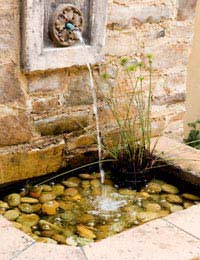 Running water adds an entirely new dimension to any garden – whether as part of a pond or as a separate stand-alone feature – bringing life movement and sound and giving even the most peaceful of gardens an even more tranquil atmosphere. The days of being faced with the stark choice of a central fountain or a waterfall have long gone – and today a wide range of water features can be found on sale, so there is something to suit all tastes and places.
Running water adds an entirely new dimension to any garden – whether as part of a pond or as a separate stand-alone feature – bringing life movement and sound and giving even the most peaceful of gardens an even more tranquil atmosphere. The days of being faced with the stark choice of a central fountain or a waterfall have long gone – and today a wide range of water features can be found on sale, so there is something to suit all tastes and places.
Waterfalls and Fountains for the Pond
For the garden pond, the traditional fountain or cascade not only provides a dynamic feel, but also plays a vital role in oxygenating the water – particularly important if there are fish. A good splash at the surface helps aerate the whole pond and the water movement within the body of the pond itself is also beneficial to ensure that the underwater environment stays healthy.
Most pond pumps come with fountain adapters, to enable a suitable spray to be created very quickly and easily and for a really showy look, a trip to the average garden centre will reveal fountain ornaments in any number of shapes, sizes and subjects – from cartoon frogs to classical statues. Though creating a waterfall takes a bit of effort to achieve, there are few things to beat a well constructed and carefully planted cascade. Of course, if you simply cannot choose between them – and your pond is big enough – there is always the option to have both.
DIY fountains and waterfalls can sometimes be a bit of a let down at first – often ending up with a considerably more feeble trickle than had been envisaged. The trick to avoid disappointment is to pay careful attention to the pump capacity and the how high it can be expected to pump water – for a fountain, the greater the height, the more impressive the display. For a waterfall, the hourly pump capacity is probably a more important consideration – as a good rule of thumb, plan on needing at least 150 litres of water per hour for every one centimetre of the waterfall’s width and buy your pump accordingly.
Features in Themselves
Water features do not have to be confined to a pond and a variety of stand-alone types – designed to be features in themselves – are readily available and generally very quick to install. With their own internal reservoir of water, in many cases all that is needed is to pick your location, perhaps do a little minimal putting together, depending on the model chosen, fill with water and then switch on. The choice is wide, from simple rustic designs, to formal ones evoking the spirit of the grand Victorian gardens and even Japanese-style units with spouts made of bamboo – ideal for the koi enthusiast wanting to capture that authentic Oriental feel.
Self-contained bubble fountains and pebble bowls are perfect for the smaller garden, while simple pot features work very well in almost any location you care to chose – and are ideal for adding a bit of interest in a forgotten corner. Ball fountains are another design which can be used in a similar way, water bubbling out of the top of the balls and flowing down over the surface, creating an interesting display as the light catches the gentle flow.
For a more formal look, there are features made for wall mounting – often in the shape of a face or animal mask which spouts water into a small trough. Where space is limited, this design of water feature can be very effective – and is hard to beat for ease of installation. If more room is available, larger floor-standing versions are available, giving a modern formal garden more than a little echo of the walled gardens of the great houses of the past. Full blown fountains too are also available and just as simple to set up, ranging from small ornamental pieces to the dramatic formal elegance of a tiered fountain, water gently cascading from one layer to the next.
Every garden can benefit from a little moving water, with or without a pond and few things can move the soul like the sound of it; add a spot of imaginative lighting and the night-time garden gets a whole new look too. As always, it is well worth consulting a qualified electrician before doing any work involving mains electricity, if only to make sure you avoid falling foul of any relevant regulations – or worse! With water and electricity, safe is always better than sorry.
Last Modified: May 24, 2022









What can I use , safely, to kill willow stumps next to my fish farm pond
@karin. You may be better placed asking a tree surgeon to come and grind them out carefully. An option is to drill holes in the stump and then pour some kind of weed killer into the holes until they rot, but this is time consuming and could harm the fish.